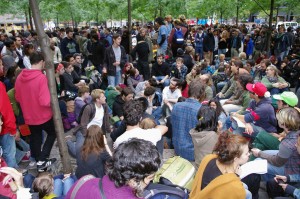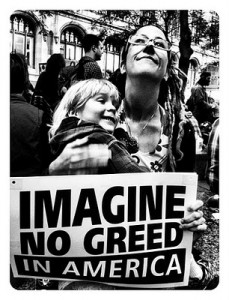
Two hundred and twenty-four years later, on September 17, 2011, individuals exercising their rights to peaceful assembly, petition, and speech began to congregate in New York City’s Zuccotti Park, formerly Liberty Plaza. Expressing a growing frustration with a government and private sector no longer perceived as working in their interest or with their consent, this gathering, known as Occupy Wall Street, has spread to over 100 cities and towns across the United States, including Wilkes-Barre, Sunbury, Danville, and Bloomsburg.
The Occupy Wall Street movement (OWS) arose out of a national groundswell of support around a very simple idea: corporations and government together have too much power. The Occupy movement supports verifiable honesty and integrity in our government, especially with regard to corporate influence. Less than 1% of Americans monetarily controls the US. A desire to peacefully restore balance to our society is what unites the remaining 99%. This is the heart of Occupy Wall Street.
Klarese Donnelley, a Bloomsburg University student and a member of the Occupy Bloomsburg Facebook page, said “This movement is important because it speaks for most of America.” She said she is not an activist, but you don’t need to be “to make a difference in the world”.

Participants were from many backgrounds. Dock workers, lawyers, hippies, nurses, engineers, teachers, bankers, veterans, and retirees all stood side by side. We left Wall Street with a strong sense that a large number of Americans from all walks of life were angry with the ill-effects corporate control has on our government. We drove home knowing we are also the 99%, and the voice of the “little guy” can indeed be heard.
Intentionally leaderless, OWS participants meet daily in local General Assemblies, during which decisions are made through a democratic process of public consensus. Each Occupy site is independent, though most strongly reflect the movements of the New York City General Assembly. Tyler Combelic, a web designer and month long protester said “I have found a voice I had thought I lost to apathy and cynicism, which has become prevalent in this country.”
In an unusual approach for a community seeking change, the movement is without specific demands. Instead, OWS has a goal: to draw attention to the imbalance of corporate power over government. It has not stipulated specific actions to take, which is a political task. There is an underlying belief that working within a “broken” system is essentially pointless, and that many changes to our government are needed before particular issues can be addressed.
This lack of immediate demands has proved a successful strategy. Critics have a difficult time arguing that a more democratic and economically balanced society is a bad idea. Even Presidential Candidate, Governor Mitt Romney, who originally said Occupy Wall Street was “dangerous… class warfare”, has come to say “I understand how those people feel.”
Although the movement is peaceful, the reaction of local governments has not always been. Several OWS protests faced strong police pressure and even violence in the form of rubber bullets, tear gas, nightsticks, pepper spray and horses.
On October 25th, Occupy Oakland was forcibly evicted from their peaceful assembly by riot police in the middle of the night. The assault left several protesters injured, including Scott Olsen, an Iraqi war veteran who suffered a fractured skull from a projectile, possibly a tear gas canister, fired from near riot police lines. This video shows police throwing a flashbang grenade into a group of people attempting to come to the aid of Mr. Olsen.

Mainstream media began its coverage of OWS by ridiculing its initial participants. Despite this, the movement rapidly grew through email, social media, texting, photos, and live video. Visuals of violent police actions and masses of protesters have widely circulated through the Internet.
Every town in America can participate through collective organization online. As an example, according to OccupyTogether.org, protest sites have formed in Danville, Sunbury, Wilkes-Barre, and other Pennsylvania towns.
In Bloomsburg, Tyler Dockery, a Bloomsburg University student and resident of Perkasie, started the Occupy Bloomsburg Facebook page. Dockery began the group because “nothing gets a message across like a group of people sharing the same ideals.”
Bucky Sparkle was born Brian Conner and raised in Bloomsburg. He now lives in rural Massachusetts with his wife and son. He is a small business owner and yoga teacher.
[Correction, 3 November: At the time this article was posted, Danville, Sunbury, and Wilkes-Barre were all listed as having Occupy movements according to Occupytogether.org. Both the internet and the Occupy movement are two very dynamic things and information changes fast and frequently. What was likely there once is not there now. A current listing of local movements can be found by going to the OccupyTogether.org Directory and entering “Pennsylvania” in the search box. -TBD]
Photo Credits: Bucky Sparkle, David Shankbone



Very nice article. So proud that you Em and KZ were part of this movement.
Well done, Bucky! Great writing and I’m proud of you!
There’s no mention of Danville on OccupyTogether.org.
Thank you. I’ll contact the author and either he or I will look into that list again and either verify the link or correct the error.
Dawg,
I contacted Bucky Sparkle, the author of the article, and he assured me that at the time he wrote the article Danville, Sunbury and Wilkes-Barre were all listed at Occupytogether.org. However, as you can see on that page now, none of those towns are listed.
Both the internet and the Occupy movement are two very dynamic things and information changes fast and frequently. What was likely there once is not there now.
I’ll correct the article to reflect this.